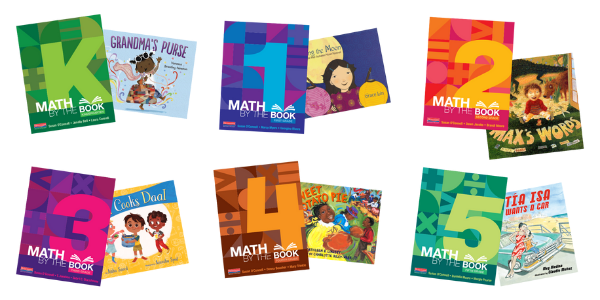
While in the past we may have simply memorized math procedures to arrive at correct answers, today’s mathematics standards ask more from our students including an understanding of how numbers work. Our goal is for our students to work flexibly with numbers and employ multiple strategies, making sense of the math they are doing.
Deep understanding requires a change to our instructional strategies. The teacher demonstrating procedures, followed by copious amounts of practice, is replaced by hands-on exploration and discovery, guided by teacher questions and framed in meaningful contexts. In this way, students develop insights, make connections between math concepts, and make sense of the math they are doing.
Models Help Number Concept Make Sense
Using concrete and representational models helps students make sense of abstract number concepts, regardless of their age. Through these experiences, they develop the ability to visualize the concepts and make sense of big ideas about numbers and number relationships.
Pairing these hands-on experiences with engaging children’s literature brings context and engagement into the equation. What could be better? Let’s look at a few examples.
Exploring Counting Numbers in Kindergarten
In kindergarten, along with learning rote counting, students explore and make sense of our counting numbers. Ten Pigs: An Epic Bath Adventure by Derek Anderson provides a fun context to explore counting numbers from 1-10.
Students might use ten frames to represent the bathtub and place one counter on the frame to show 1 pig in the tub. As each pig jumps into the tub, students act out the story by adding a counter to their ten frame and then counting to find the total pigs in the tub. As they model the story and talk with partners, they notice that one more than 1 is 2 and one more than 2 is 3 and one more than 3 is 4 and recognize a pattern. They use their observations to predict the number of pigs in the tub by thinking about one more as the next number in the counting sequence. Students experience an aha moment in which they discover a foundational concept in our number system – that each number in the counting sequence represents a quantity that is one more than the number said before it.
As they model the story and talk with partners, they notice that one more than 1 is 2 and one more than 2 is 3 and one more than 3 is 4 and recognize a pattern. They use their observations to predict the number of pigs in the tub by thinking about one more as the next number in the counting sequence. Students experience an aha moment in which they discover a foundational concept in our number system – that each number in the counting sequence represents a quantity that is one more than the number said before it.
Exploring Even and Odd Numbers in Second Grade
Rather than telling second grade students the definition of odd and even numbers, a story like Even Steven and Odd Todd by Kathryn Cristaldi sets a context for them to figure out what these terms mean. Through the silly adventures of Steven and Todd, students notice the numbers associated with each character and use that story data to consider what it might mean for a number to be even or odd.
Students might create towers of connecting cubes and notice that towers of 2, 4, 6, 8, 10, or 12 cubes can be split into 2 equal towers, while towers of 3, 5, 7, or 9 cubes cannot be split evenly. They might use a 1-20 chart and highlight numbers associated with Even Steven to see if any patterns appear, noticing that every other number is even or noticing that the even numbers are the sums of doubles facts. Through examples from the story, student-created models, and lots of math talk, students craft their own definitions of odd and even numbers.
They might use a 1-20 chart and highlight numbers associated with Even Steven to see if any patterns appear, noticing that every other number is even or noticing that the even numbers are the sums of doubles facts. Through examples from the story, student-created models, and lots of math talk, students craft their own definitions of odd and even numbers.
Exploring Prime and Composite Numbers in Fourth Grade
It's a common misconception that manipulatives are only for younger students and that by third or fourth grade our students somehow outgrow the need for concrete models. Nothing could be further from the truth.
Bean Thirteen by Matthew McElligott is a delightful book about two crickets, Ralph and Flora, who are picking beans for dinner with friends. Against Flora’s protests, Ralph insists on picking an unlucky 13th bean. Can they share the beans fairly with their friends? After reading the story, students create arrays with square tiles, and later grid paper models, to explore ways to fairly share various numbers of beans (e.g., 13, 18, 24).
Following the investigation, the teacher poses questions to guide students as they observe their models and consider ways to identify and organize the factor pairs. Armed with a visualization and understanding of factor pairs, students notice that some quantities have many factor pairs (the beans could be fairly shared in different ways), while others only have one pair (the beans cannot be shared fairly or the only factors are 1 and the number), constructing meaning to the concepts of prime and composite numbers.
Promoting Mathematical Thinking Through Story Contexts
Context and models expand students’ understanding of numbers and help them make sense of important number concepts. A story context engages students and provides a situation to explore the abstract ideas. It brings the math to life and invites students to take part. Models allow students to visualize and make sense of numbers, allowing them to see them, talk about what they see, and notice big ideas. The pairing of models and context helps students create mental images that allow them to transfer their insights to the abstract representations, expanding their understanding of critical number concepts.

Sue O’Connell has decades of experience supporting teachers in making sense of mathematics and effectively shifting how they teach. A former elementary teacher, reading specialist, and math coach, she is also a nationally known speaker and education consultant who currently directs Quality Teacher Development, an organization providing math professional development for schools and districts across the country. Sue is also the lead author of the Math in Practice series.

Donna Boucher has been a classroom teacher, math instructional coach, interventionist, and curriculum coordinator. A frequent speaker at state and national conferences, she shares her love for math with a worldwide audience through her website, Math Coach’s Corner.


